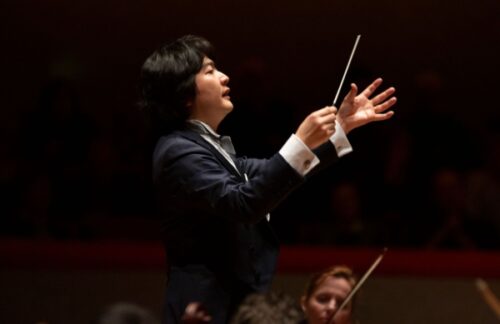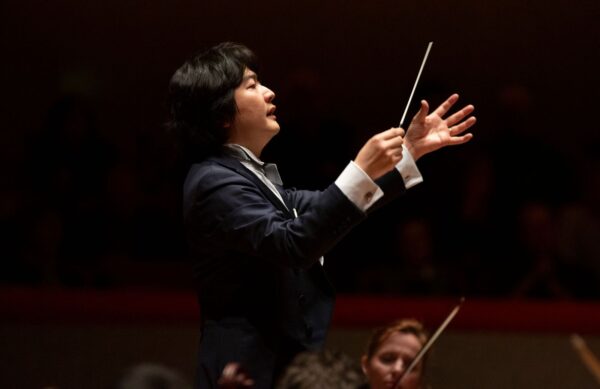 United Kingdom Ravel, Berg, Saint-Saëns: Baiba Skride (violin), Stephen Farr (organ), Philharmonia Orchestra / Kazuki Yamada (conductor). Royal Festival Hall, London, 7.5.2023. (MBr)
United Kingdom Ravel, Berg, Saint-Saëns: Baiba Skride (violin), Stephen Farr (organ), Philharmonia Orchestra / Kazuki Yamada (conductor). Royal Festival Hall, London, 7.5.2023. (MBr)

Ravel – Pavane pour une infante défunte
Berg – Violin Concerto
Saint-Saëns – Symphony No.3, ‘Organ’
Before I began writing this review I spent a considerable amount of time asking myself the question: how do we measure a truly great performance of a work? I certainly seem to hear less of them these days; some of the most remarkable seem to be back ended to my much younger adult years when I lived in Germany. The finest performances of Mahler, Schoenberg, Bruckner and Strauss largely come from before I began to write reviews. Even the finest Rite of Spring I recall goes back to 1991 (Boulez/Philharmonia).
Saint-Saën’s Third Symphony, which before this concert given by the Philharmonia Orchestra conducted by the Japanese conductor Kazuki Yamada, I probably hadn’t heard for almost thirty years, seems an odd contender for ‘great performance’. A rather lurid, virtuoso extravaganza of a piece it is in no sense a conventional symphony – although unquestionably radical for its time; it’s very much one of the orphans of the Berlioz tradition of French symphonic writing. I have not heard a bad performance of it, however – Barenboim in Paris, and Myung-Wha Chung, in a now famous one with the London Symphony Orchestra, were both tremendous – but perhaps it is the kind of work which just fails to fail. But ‘fail to fail’ and making a triumphant success of this symphony are entirely different.
Kazuki Yamada is an absolute dynamo of a conductor – indeed, the friend I took to this concert said he reminded him of a young Celibidache (although Bernstein also comes to mind). A less charitable view would be that Yamada could be a tad histrionic except for the fact almost everything he does has a purpose and gets a response from the orchestra. He more than once risked toppling into the first violins simply to get them to play deeper; he swayed his entire torso from left to right to get the right kind of crescendo he wanted. When he needed to shape phrases he stopped using the baton and reverted to his hands instead. However staged it looked it clearly gets results – as it did for Celi and Lenny.
What was unusual about the performance was how beautiful he made the symphony sound, how keen he was for the music to speak through very shrewd detail he gave to individual instruments. The Adagio, for example, was sublime: the gorgeous underbelly of the organ against the strings felt like a genuine dialogue. Stephen Farr’s playing, so fabulously contoured, and shrouded in mist here, was just magical. Later, from the blazing C major hammered opening to the chorale-like chords with the strings, he would prove majestic.
Although Saint-Saëns is not as brilliant an orchestrator as Richard Strauss, Yamada almost made us feel that he was. Nothing in this symphony comes remotely close to Eine Alpensinfonie, for example, and yet Yamada brought out an unusual parallel between the two works, especially in how Strauss would use the organ himself (notably in ‘Vision’) when he came to compose his great orchestral mountain climb.
The ‘Organ’ is very much about dramatic changes in texture and colour – and this performance almost seemed to drip with them. The brooding introduction, with strings just the right end of deep to allow for a change in dynamics, was Lisztian. The first time we heard the ‘Dies Irae’ – which would become a zealous, fiery reincarnation in the final movement – it was unmasked over the full escalating terror of the orchestra, the illusion of its medieval magic just intact. The Scherzo had been wild – demonic, cascading figures on the piano like rattling bones, brass fugues pitched deep and resonant. Yamada pulled from the strings precisely the sonorous, consonant tone he wanted – and he got it. A clenched, quivering fist has rarely been used to better effect.
The final movement was remarkable. It is comparatively easy to make an orchestra play well – or to get the music to sound as one wants it to. It is much more difficult to get both to mesh, especially in the way that Yamada did. No matter how elaborate, or maze-like in its complexity it became, it unwound with astonishing coherence and thought. There are many adjectives or nouns I can throw at what we got here: a precision-perfect orchestral gyroscope, a ‘Dies Irae’ that seemed to combine the power of a turbine and a furnace, or simply an orchestra on such phenomenal virtuosic form it was hyperventilating with the kind of dramatic compass one rarely hears in concerts these days. The coda was insane, quite frankly. Celibidache almost lost the LSO during a performance of Kodály’s Dances of Galanta – Yamada welded the Philharmonia tightly to the score in the most impressive way so the very idea this orchestra and conductor would drift apart became unthinkable. Magnificent stuff.
I asked at the beginning of the review how do we measure greatness? I think in different ways. Karajan in Schoenberg is clearly very different than Yamada in Saint-Saëns. However, I struggled to think after this concert of a more exhilarating, more virtuosic, more thrilling performance of a symphony I have heard in a concert in the recent past. None came to mind.
The concert’s opening work, Ravel’s Pavane pour une infante défunte hinted at the kind of performance we would get in the Saint-Saëns. Yamada’s care for instrumental detail, the expressive hands and sweeping meaningful gestures, all brought out intricacies in the work. It’s also a rather cruel piece with which to open a concert, especially if you are a horn player (the only brass Ravel scored the work for). It wasn’t always secure, but it was mercurial in tone, blushed with just the right kind of subtleness. There was nothing heavy about this performance, nothing funereal, but as always with this orchestra in French music, the woodwind were sublime – evocative phrasing, perfect tone and a mellowness and warmth that is still so uniquely this orchestra’s. If perhaps I felt Yamada over-balanced Ravel’s dynamics in favour of rather louder ones in the woodwind it added an astringency and austerity to the music’s beauty which probably seemed right.
I have largely avoided Alban Berg’s Violin Concerto in the concert hall. The work is magnificent; performances tend not to be from my experience, however. Rather like Suk’s Asrael Symphony, the Berg concerto is overburdened by both personal tragedy and autobiography and interpretations of these works have often sounded to me overwrought for quite the wrong reasons. One reason why Louis Krasner’s own recording of the concerto – with Anton Webern – is so convincing is because it is so straight; but it is also hugely powerful and after you have heard it you rather feel like your skin has been scrubbed down with acid.
Baiba Skride was the soloist here and her performance largely worked for me because she placed some distance between the work’s tragic inspiration and how she was able to objectify this. Skribe’s Manon wasn’t a notably shy one from the outset; Skribe’s warm, mellow tone doesn’t really make us see her this way (Anne-Sophie Mutter even less so, I seem to remember). But in no sense were the scherzando or rustico sections heavily managed either; they were buoyant, rhythmic and spritely. As often happens with Berg – in Wozzeck, for example – when he composes for moments of terror and sheer horror it comes through the orchestra and the instrument (or singer) are often left hanging in the wind. The death of Manon largely accrues its power through the orchestra – the hammered out fate rhythm – but there was a searing, gut-wrenching quality to Skribe’s playing. I don’t think she quite managed to cut through the orchestra as far as she might have – these were more blunt edges rather than razor sharp shards. A bow wielded with the savagery of a knife has sometimes been better applied here.
The Bach Chorale section was beautifully done – and typically well managed by Yamada in harmonisation with the clarinets. The intricate lament was the right side of heartfelt – impassioned, with an element of fiery intensity to it. At the end of the coda was a sudden crescendo which sounded like the dial of a radio being turned up and down. A fine performance.
But this was a concert that will be remembered for a glorious Saint-Saëns Third Symphony of unmatched brilliance with a conductor and orchestra channelling rare, incandescent symmetry. Magnificent.
Marc Bridle
